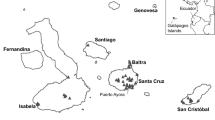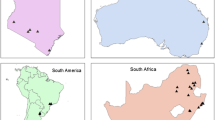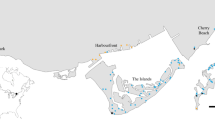Abstract
The ecological and evolutionary dynamics of newly introduced invasive species can best be understood by identifying the source population(s) from which they originated, as many species vary behaviorally, morphologically, and genetically across their native landscapes. We attempt to identify the source(s) of the red imported fire ant (Solenopsis invicta) in the southern USA utilizing data from three classes of genetic markers (allozymes, microsatellites, and mitochondrial DNA sequences) and employing Bayesian clustering simulations, assignment and exclusion tests, and phylogenetic and population genetic analyses. We conclude that the Mesopotamia flood plain near Formosa, Argentina represents the most probable source region for introduced S. invicta among the 10 localities sampled across the native South American range. This result confirms previous suspicions that the source population resides in northern Argentina, while adding further doubts to earlier claims that the Pantanal region of Brazil is the source area. Several lines of evidence suggest that S. invicta in the southern USA is derived from a single location rather than being the product of multiple invasions from widely separated source localities. Although finer-scale sampling of northern Argentina and Paraguay combined with the use of additional genetic markers will be necessary to provide a highly precise source population assignment, our current results are of immediate use in directing future sampling and focusing ongoing biological control efforts.









Similar content being viewed by others
References
Ahrens ME, Ross KG, Shoemaker DD (2005) Phylogeographic structure of the fire ant Solenopsis invicta in its native South American range: roles of natural barriers and habitat connectivity. Evolution 59:1733–1743
Allen GE, Buren WF (1974) Microsporidan and fungal diseases of Solenopsis invicta Buren in Brazil. J NY Entomol Soc 82:125–130
Allen CR, Lutz RS, Demarais S (1998) Ecological effects of the invasive nonindigenous ant, Solenopsis invicta, on native vertebrates: the wheels on the bus. Trans N Am Wildl Nat Res Conf 63:56–65
Baudouin L, Piry S, Cornuet JM (2004) Analytical Bayesian approach for assigning individuals to populations. Heredity 95:217–224
Buckley A (1999) Fire ants in California. Am Bee J 139:88
Buren WF (1972) Revisionary studies on the taxonomy of the imported fire ants. Georgia Entomol Soc 7:1–26
Buren WF, Allen GE, Whitcomb WH, Lennartz FE, Williams RN (1974) Zoogeography of the imported fire ants. J NY Entomol Soc 82:113–124
Callcott AMA, Collins HL (1996) Invasion and range expansion of imported fire ants (Hymenoptera: Formicidae) in North America from 1918–1995. Fla Entomol 79:240–251
Carroll CR, Hoffman CA (2000) The pervasive ecological effects of invasive species: Exotic and native fire ants. In: Coleman DC, Hendrix PF (eds) Invertebrates as Web-masters in ecosystems. Wallingford, Oxon, pp 221–232
Carruthers RI (2003) Invasive species research in the United States Department of Agriculture – Agricultural Research Service. Pest Manage Sci 59:827–834
Chakraborty R, Nei M (1977) Bottleneck effects on average heterozygosity and genetic distance with the stepwise mutation model. Evolution 31:347–356
Chen JSC, Shen CH, Lee HJ (2006) Monogynous and polygynous red imported fire ants, Solenopsis invicta Buren (Hymenoptera: Formicidae), in Taiwan. Environm Entomol 35:167–172
Cornuet JM, Piry S, Luikart G, Estoup A, Solignac M (1999) New methods employing multilocus genotypes to select or exclude populations as origins of individuals. Genetics 153:1989–2000
Davis LR, Vander Meer RK, Porter SD (2001) Red imported fire ants expand their range across the West Indies. Fld Entomol 84:735–736
Downie DA (2002) Locating the sources of an invasive pest, grape phylloxera, using a mitochondrial DNA gene genealogy. Mol Ecol 11:2013–2026
Dybdahl MF, Storfer A (2003) Parasite local adaptation: red queen versus suicide king. Trends Ecol Evol 18:523–530
Evanno G, Regnaut S, Goudet J (2005) Detecting the number of clusters of individuals using the software STRUCTURE: a simulation study. Mol Ecol 14:2611–2620
Falush D, Stephens M, Pritchard JK (2003) Inference of population structure using multilocus genotype data: linked loci and correlated allele frequencies. Genetics 164:1567–1587
Felsenstein J (2004) PHYLIP (Phylogeny Inference Package) version 3.6. Department of Genome Sciences, University of Washington, Seattle
Foitzik S, Fischer B, Heinze J (2003) Arms races between social parasites and their hosts: geographic patterns of manipulation and resistance. Behav Ecol 14:80–88
Folgarait PJ, Bruzzone O, Porter SD, Pesquero MA, Gilbert LE (2005) Biogeography and macroecology of phorid flies that attack fire ants in south-eastern Brazil and Argentina. J Biogeogr 32:353–367
Giraud T, Pedersen JS, Keller L (2002) Evolution of supercolonies: the Argentine ants of southern Europe. Proc Natl Acad Sci USA 99:6075–6079
Glaubitz JC (2004) CONVERT: a user-friendly program to reformat diploid genotypic data for commonly used population genetic software packages. Mol Ecol Notes 4:309–310
Goolsby JA, DeBarro PJ, Makinson JR, Pemberton RW, Hartley DM, Frohlich DR (2006) Matching the origin of an invasive weed for selection of a herbivore haplotype for a biological control programme. Mol Ecol 15:287–297
Gotelli NJ, Arnett AE (2000) Biogeographic effects of red fire ant invasion. Ecol Lett 3:257–261
Gotzek D, Ross KG (2007) Genetic regulation of colony social organization in fire ants: an integrative overview. Q Rev Biol 82:201–226
Gotzek D, Shoemaker D, Ross KG (2007) Molecular variation at a candidate gene implicated in the regulation of fire ant social behavior. PLoS ONE 2:e1088. doi:10.1371/journal.pone.0001088
Gwiazdowski RA, Van Driesche RG, Desnoyers A, Lyon S, Wu Sa, Kamata N, Normark BB (2006) Possible geographic origin of beech scale, Cryptococcus fagisuga (Hemiptera: Eriococcidae), an invasive pest in North America. Biol Control 39:9–18
Harter AV, Gardner KA, Falush D, Lentz DL, Bye RA, Rieseberg LH (2004) Origin of extant domesticated sunflowers in eastern North America. Nature 430:201–205
Havill NP, Montgomery ME, Yu G, Shiyake S, Caccone A (2006) Mitochondrial DNA from hemlock woolly adelgid (Hemiptera: Adelgidae) suggests cryptic speciation and pinpoints the source of the introduction to eastern North America. Ann Entomol Soc Am 99:195–203
Huang TC, Chou YC, Chou HC (2004) The infestation and control of the red imported fire ant in Taiwan. In: Proceedings of the symposium on the control of the red imported fire ant, Bureau of animal and plant health inspection and quarantine, Council of Agriculture, Executive Yuan, Taipei, Taiwan
Jarne P, Lagoda PJL (1996) Microsatellites: from molecules to populations and back. Trends Ecol Evol 11:424–429
Jouvenaz DP (1990) Approaches to biological control of fire ants in the United States. In: Vander Meer RK, Jaffe K, Cedeno A (eds) Applied myrmecology: a world perspective. Westview Press, Boulder, pp 620–627
Kaltz O, Shykoff JA (1998) Local adaptation in host-parasite systems. Heredity 81:361–370
Kemp SF, deShazo RD, Moffitt JE, Williams DF, Buhner WA (2000) Expanding habitat of the imported fire ant (Solenopsis invicta): a public health concern. J Allergy Clin Immunol 105:683–691
Kraaijeveld AR, Godfray HCJ (1999) Geographic patterns in the evolution of resistance and virulence in Drosophila and its parasitoids. Am Nat 153:S61–S74
Krieger MJB, Ross KG (2002) Identification of a major gene regulating complex social behavior. Science 295:328–332
Laine AL (2005) Spatial scale of local adaptation in a plant-pathogen metapopulation. J Evol Biol 18:930–938
Lee CE (2002) Evolutionary genetics of invasive species. Trends Ecol Evol 17:386–391
Lively CM, Dybdahl MF (2000) Parasite adaptation to locally common host genotypes. Nature 405:679–681
Lively CM, Dybdahl MF, Jokela J, Osnas EE, Delph LF (2004) Host sex and local adaptation by parasites in a snail-trematode interaction. Am Nat 164:S6–S18
Lofgren CS (1986a) History of imported fire ants in the United States. In: Lofgren CS, Vander Meer RK (eds) Fire ants and leaf cutting ants: biology and management. Westview Press, Boulder, pp 36–49
Lofgren CS (1986b) The economic importance and control of imported fire ants in the United States Economic impact and control of social insects. Praeger, New York, pp 227–256
Lofgren CS, Banks WA, Glancey BM (1975) Biology and control of imported fire ants. Ann Rev Entomol 20:1–30
MacKay WP, Fagerlund R (1997) Range expansion of the red imported fire ant, Solenopsis invicta Buren (Hymenoptera: Formicidae), into New Mexico and extreme western Texas. Proc Entomol Soc Wash 99:757–758
May GE, Gelembiuk GW, Panov VE, Orlova MI, Lee CE (2006) Molecular ecology of zebra mussel invasions. Mol Ecol 15:1021–1031
McCubbin KI, Weiner JM (2002) Fire ants in Australia: a new medical and ecological hazard. Med J Aust 176:518–519
Mehdiabadi NJ, Gilbert LE (2002) Colony-level impacts of parasitoid flies on fire ants. Proc R Soc Biol Sci (Series B) 269:1695–1699
Mehdiabadi NJ, Kawazoe EA, Gilbert LE (2004) Phorid fly parasitoids of invasive fire ants indirectly improve the competitive ability of a native ant. Ecol Entomol 29:621–627
Mescher MC, Ross KG, Shoemaker DD, Keller L, Krieger MJB (2003) Distribution of the two social forms of the fire ant Solenopsis invicta (Hymenoptera: Formicidae) in the native South American range. Ann Entomol Soc Am 96:810–817
Mitchell CE, Power AG (2003) Release of invasive plants from fungal and viral pathogens. Nature 421:625–627
Miura O, Torchin ME, Kuris AM, Hechinger RF, Chiba S (2006) Introduced cryptic species of parasites exhibit different invasion pathways. Proc Am Acad Arts Sci USA 103:19818–19823
Morrison LW (2000) Mechanisms of interspecific competition among an invasive and two native fire ants. Oikos 90:238–252
Morrison LW (2002) Long-term impacts of an arthropod-community invasion by the imported fire ant, Solenopsis invicta. Ecology 83:2337–2345
Morrison LW, Porter SD (2005) Phenology and parasitism rates in introduced populations of Pseudacteon tricuspis, a parasitoid of Solenopsis invicta. Biocontrol 50:127–141
Morrison LW, Kawazoe EA, Guerra R, Gilbert LE (2000) Ecological interactions of Pseudacteon parasitoids and Solenopsis ant hosts: environmental correlates of activity and effects on competitive hierarchies. Ecol Entomol 25:433–444
Nei M, Tajima F, Tateno Y (1983) Accuracy of estimated phylogenetic trees from molecular data. II. Gene frequency data. J Mol Evol 19:153–170
Orr MR (1996) Host manipulation by Wolbachia is a neutral trait within single populations. Anim Behav 51:1183–1185
Paetkau D, Slade R, Burdents M, Estoup A (2004) Genetic assignment methods for the direct, real-time estimation of migration rate: a simulation-based exploration of accuracy and power. Mol Ecol 13:55–65
Patterson RS (1994) Biological control of introduced ant species. In: Williams DF (ed) Exotic ants: biology, impact, and control of introduced species. Westview Press, Boulder, pp 293–308
Pereira RM, Porter SD (2006) Range expansion of the fire ant decapitating fly, Pseudacteon tricuspis, eight to nine years after releases in North Florida. Fla Entomol 89:536–538
Piry S, Alapetite A, Cornuet J-M, Paetkau D, Budouin L, Estoup A (2004) GENECLASS2: a software for genetic assignment and first-generation migrant detection. J Hered 95:536–539
Pitts JP (2002) A cladistic analysis of the Solenopsis saevissima species-group (Hymenoptera: Formicidae). Ph.D., Entomology, University of Georgia, Athens, GA
Pitts JP, McHugh JV, Ross KG (2005) Cladistic analysis of the fire ants of the Solenopsis saevissima species-group (Hymenoptera: Formicidae). Zool Scr 34:493–505
Porter SD (1998) Host-specific attraction of Pseudacteon flies (Diptera: Phoridae) to fire ant colonies in Brazil. Fla Entomol 81:423–429
Porter SD (2000) Host specificity and risk assessment of releasing the decapitating fly Pseudacteon curvatus as a classical biocontrol agent for imported fire ants. Biol Control 19:35–47
Porter SD, Alonso LE (1999) Host specificity of fire ant decapitating flies (Diptera: Phoridae) in laboratory oviposition tests. J Econ Entomol 92:110–114
Porter SD, Briano JA (2000) Parasitoid-host matching between the little decapitating fly Pseudacteon curvatus from Las Flores, Argentina and the black fire ant Solenopsis richteri. Fla Entomol 83:422–427
Porter SD, Savignano DA (1990) Invasion of polygyne fire ants decimates native ants and disrupts arthropod community. Ecology 7:2095–2106
Porter SD, Fowler HG, MacKay WP (1992) Fire ant mound densities in the United States and Brazil (Hymenoptera: Formicidae). J Econ Entomol 85:1154–1161
Porter SD, Pesquero MA, Campiolo S, Fowler HG (1995) Growth and development of Pseudacteon phorid fly maggots (Diptera: Phoridae) in the heads of Solenopsis fire ant workers (Hymenoptera: Formicidae). Environm Entomol 24:475–479
Porter SD, Williams DF, Patterson RS (1997a) Rearing the decapitating fly Pseudacteon tricuspis (Diptera: Phoridae) in imported fire ants (Hymenoptera: Formicidae) from the United States. J Econ Entomol 90:135–138
Porter SD, Williams DF, Patterson RS, Fowler HG (1997b) Intercontinental differences in the abundance of Solenopsis fire ants (Hymenoptera: Formicidae): escape from natural enemies? Environ Entomol 26:373–384
Porter SD, de Sa LAN, Morrison LW (2004) Establishment and dispersal of the fire ant decapitating fly Pseudacteon tricuspis in North Florida. Biol Control 29:179–188
Posada D, Crandall KA (1998) MODELTEST: testing the model of DNA substitution. Bioinformatics 19:817–818
Pritchard JK, Stephens M, Donnelly P (2000) Inference of population structure using multilocus genotype data. Genetics 155:945–959
Provan J, Murphy S, Maggs CA (2005) Tracking the invasive history of the green alga Codium fragile ssp. tomentosoides. Mol Ecol 14:189–194
Rannala B, Mountain JL (1997) Detecting immigration by using multilocus genotypes. Proc Natl Acad Sci USA 94:9197–9201
Ronquist F, Huelsenbeck JP (2003) MrBayes 3: Bayesian phylogenetic inference under mixed models. Bioinformatics 19:1572–1574
Rosenberg NA (2004) DISTRUCT: a program for the graphical display of population structure. Mol Ecol Notes 4:137–138
Ross KG, Shoemaker DD (1997) Nuclear and mitochondrial genetic structure in two social forms of the fire ant Solenopsis invicta: insights into transitions to an alternate social organization. Heredity 78:590–602
Ross KG, Shoemaker DD (2005) Species delimitation in native South American fire ants. Mol Ecol 14:3419–3438
Ross KG, Trager JC (1990) Systematics and population genetics of fire ants (Solenopsis saevissima complex) from Argentina. Evolution 44:2113–2134
Ross KG, Vargo EL, Keller L, Trager JC (1993) Effect of a founder event on variation in the genetic sex-determining system of the fire ant Solenopsis invicta. Genetics 135:843–854
Ross KG, Vargo EL, Keller L (1996) Social evolution in a new environment: the case of introduced fire ants. Proc Natl Acad Sci USA 93:3021–3025
Ross KG, Keller L (1995) Ecology and evolution of social organization: insights from fire ants and other highly eusocial insects. Annu Rev Ecol Syst 26:631–656
Ross KG, Krieger MJB, Shoemaker DD, Vargo EL, Keller L (1997) Hierarchical analysis of genetic structure in native fire ant populations: results from three classes of molecular markers. Genetics 147:643–655
Ross KG, Krieger MJB, Keller L, Shoemaker DD (2007) Genetic variation and structure in native populations of the fire ant Solenopsis invicta: evolutionary and demographic implications. Biol J Linn Soc 92:541–560
Sakai AK, Allendorf FW, Holt JS, Lodge DM, Molofsky J, With KA, Baughman S, Cabin RJ, Cohen JE, Ellstrand NC, McCauley DE, O’Neil P, Parker IM, Thompson JN, Weller SG (2001) The population biology of invasive species. Annu Rev Ecol Syst 32:305–332
Sax DF, Stachowicz JJ, Gaines SD (2005) Species invasions: Insights into ecology, evolution, and biogeography. Sinauer Associates, Sunderland, 495 pp
Schneider S, Roessli D, Excoffier L (2000) Arlequin ver. 2.000: a software for population genetic data analysis. Genetics Biometry Laboratory, University of Geneva, Switzerland
Shoemaker DD, Costa JT, Ross KG (1992) Estimates of heterozygosity in two social insects using a large number of electrophoretic markers. Heredity 69:573–582
Shoemaker DD, Ross KG, Arnold ML (1996) Genetic structure and evolution of a fire ant hybrid zone. Evolution 50:1958–1976
Shoemaker DD, Ahrens M, Ross KG (2006a) Molecular phylogeny of fire ants of the Solenopsis saevissima species-group based on mitochondrial DNA sequences. Mol Phylogenet Evol 38:200–215
Shoemaker DD, DeHeer CJ, Krieger MJB, Ross KG (2006b) Population genetics of the invasive fire ant Solenopsis invicta (Hymenoptera: Formicidae) in the U.S.A. Ann Entomol Soc Am 99:1213–1233
Simon C, Frati F, Beckenbach A, Crespi B, Liu H, Flook P (1994) Evolution, weighting, and phylogenetic utility of mitochondrial gene sequences and a compilation of conserved polymerase chain reaction primers. Ann Entomol Soc Am 81:651–701
Swofford DL (1999) PAUP*. Phylogenetic analysis using parsimony (*and other methods), version 4.0. Sinauer Associates, Sunderland, MA
Thrall PH, Burdon JJ, Bever JD (2002) Local adaptation in the Linum marginale–Melampsora lini host-pathogen interaction. Evolution 56:1340–1351
Torchin ME, Lafferty KD, Dobson AP, McKenzie VJ, Kuris AM (2003) Introduced species and their missing parasites. Nature 421:628–630
Trager JC (1991) A revision of the fire ants, Solenopsis geminata group (Hymenoptera: Formicidae: Myrmicinae). J NY Entomol Soc 99:141–198
Tschinkel WR (2006) The fire ants. Harvard University Press, Cambridge, 752 pp
Tsutsui ND, Suarez AV, Grosberg RK (2003) Genetic diversity, asymmetrical aggression, and recognition in a widespread invasive species. Proc Natl Acad Sci USA 100:1078–1083
Vazquez RJ, Porter SD, Briano JA (2004) Host specificity of a biotype of the fire ant decapitating fly Pseudacteon curvatus (Diptera: Phoridae) from northern Argentina. Environ Entomol 33:1436–1441
Vinson SB (1994) Impact and invasion of Solenopsis invicta (Buren) on native food webs. In: Williams DF (ed) Exotic ants: biology, impact, and control of introduced species. Westview Press, Boulder, pp 293–308
Waage JK, Mills NJ (1992) Biological control. In: Crawley MJ (ed) Natural enemies: the population biology of predators, parasites, and diseases. Blackwell Scientific Publications, Cambridge, pp 412–430
Wilcove DS, Rothstein D, Dubow J, Phillips A, Losos E (1998) Quantifying threats to imperiled species in the United States. Bioscience 48:607–615
Williams DF (1994) Control of the introduced pest Solenopsis invicta in the United States. In: Williams DF (ed) Exotic ants. Biology, impact, and control of introduced species. Westview Press, Boulder, pp 282–292
Williams DF, deShazo RD (2004) Biological control of fire ants: an update on new techniques. Ann Allergy Asthma Immunol 93:15–22
Williams DF, Porter SD (1994) Fire ant control. Science 264:1653–1653
Wojcik D, Allen CR, Brenner RJ, Forys EA, Jouvenaz D, Lutz RS (2001) Red imported fire ants: Impact on biodiversity. Am Entomol 47:16–23
Acknowledgements
We thank Laurent Keller and Mark Mescher for help collecting ants and Dietrich Gotzek for comments on an earlier draft of the manuscript. This study was supported by a grant from the United States Department of Agriculture NRICGP (2006-35302-18001; Agreement No. 58-6615-7-137). The use of trade, firm, or corporation names in this publication is for the information and convenience of the reader. Such use does not constitute an official endorsement or approval by the United States Department of Agriculture or the Agricultural Research Service of any product or service to the exclusion of others that may be suitable. Any opinions, findings, conclusion, or recommendations expressed in this publication are those of the author(s) and do not necessarily reflect the view of the U.S. Department of Agriculture.
Author information
Authors and Affiliations
Corresponding author
Appendices
Appendices
Rights and permissions
About this article
Cite this article
Caldera, E.J., Ross, K.G., DeHeer, C.J. et al. Putative native source of the invasive fire ant Solenopsis invicta in the USA. Biol Invasions 10, 1457–1479 (2008). https://doi.org/10.1007/s10530-008-9219-0
Received:
Accepted:
Published:
Issue Date:
DOI: https://doi.org/10.1007/s10530-008-9219-0




